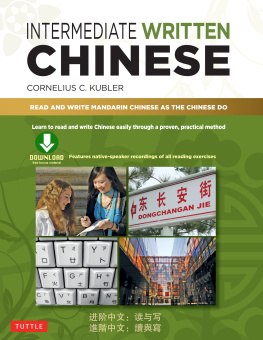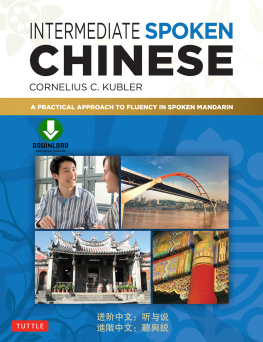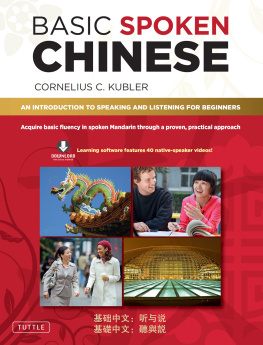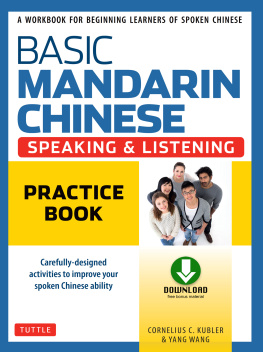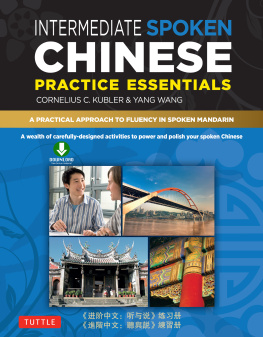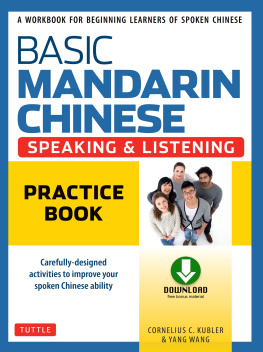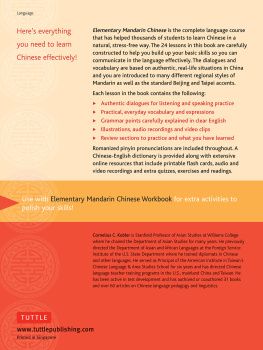Cornelius C. Kubler - Intermediate Written Chinese
Here you can read online Cornelius C. Kubler - Intermediate Written Chinese full text of the book (entire story) in english for free. Download pdf and epub, get meaning, cover and reviews about this ebook. publisher: Tuttle Publishing, genre: Home and family. Description of the work, (preface) as well as reviews are available. Best literature library LitArk.com created for fans of good reading and offers a wide selection of genres:
Romance novel
Science fiction
Adventure
Detective
Science
History
Home and family
Prose
Art
Politics
Computer
Non-fiction
Religion
Business
Children
Humor
Choose a favorite category and find really read worthwhile books. Enjoy immersion in the world of imagination, feel the emotions of the characters or learn something new for yourself, make an fascinating discovery.
- Book:Intermediate Written Chinese
- Author:
- Publisher:Tuttle Publishing
- Genre:
- Rating:5 / 5
- Favourites:Add to favourites
- Your mark:
- 100
- 1
- 2
- 3
- 4
- 5
Intermediate Written Chinese: summary, description and annotation
We offer to read an annotation, description, summary or preface (depends on what the author of the book "Intermediate Written Chinese" wrote himself). If you haven't found the necessary information about the book — write in the comments, we will try to find it.
Intermediate Written Chinese — read online for free the complete book (whole text) full work
Below is the text of the book, divided by pages. System saving the place of the last page read, allows you to conveniently read the book "Intermediate Written Chinese" online for free, without having to search again every time where you left off. Put a bookmark, and you can go to the page where you finished reading at any time.
Font size:
Interval:
Bookmark:
Abbreviations
Word Classes
| [A] | Adverb |
| [AT] | Attributive |
| [AV] | Auxiliary Verb |
| [BF] | Bound Form |
| [CJ] | Conjunction |
| [CV] | Coverb |
| [EV] | Equative Verb |
| [EX] | Expression |
| [I] | Interjection |
| [IE] | Idiomatic Expression |
| [L] | Localizer |
| [M] | Measure |
| [MA] | Moveable Adverb |
| [N] | Noun |
| [NU] | Number |
| [P] | Particle |
| [PH] | Phrase |
| [PR] | Pronoun |
| [PT] | Pattern |
| [PV] | Postverb |
| [PW] | Place Word |
| [QW] | Question Word |
| [RC] | Resultative Compound |
| [RE] | Resultative Ending |
| [SN] | Surname |
| [SP] | Specifier |
| [SV] | Stative Verb |
| [TW] | Time Word |
| [V] | Verb |
| [VO] | Verb-Object Compound |
Other Abbreviations and Symbols
| (B) | Beijing |
| (T) | Taipei |
| lit. | literally |
| / | (separates alternate forms) |
| (supplemental vocabulary written with new characters) | |
| (supplemental vocabulary written with familiar characters) |
For explanations of these word classes, see the section Word Classes of Spoken Chinese on pages 354364 of Basic Spoken Chinese (Tuttle Publishing, 2011).
About This Course
Intermediate Spoken Chinese and Intermediate Written Chinese constitute the second level of a comprehensive course in modern Chinese (Mandarin), the language with the largest number of native speakers in the world, the official language of mainland China and Taiwan and one of the official languages of Singapore. The focus of this course, which is designed for adult English-speaking learners, is on communicating in Chinese in practical, everyday situations. We have tried to keep in mind the needs of a wide range of users, from college and university students to business people and government personnel. With some adjustments in the rate of progress, high school students may also be able to use these materials to their advantage. By availing themselves of the detailed usage notes and making good use of the Practice Essentials books, the video, and the audio, it is even possible for motivated self-learners to work through these materials on their own, though it would be desirable for them to meet with a teacher or native speaker for an hour or two per week, if possible. Although users with specialized needs will, in the later stages of their study, require supplementary materials, we believe this course provides a solid general foundation or base (hence the title of the course) that all learners of Chinese need, on which they may build for future mastery.
The course is divided into spoken and written tracks, each with various types of ancillary materials. The following diagram will clarify the organization of the whole course:

Several modes of study are possible for these materials: (1) the spoken series only; (2) a lesson in the spoken series followed a few days, weeks, or months later by the corresponding lesson in the written series; and (3) a lesson in the spoken and written series studied simultaneously. What is not possible is to study the written series first or only, since the written series assumes knowledge of the pronunciation system and relevant grammatical and cultural information, which are introduced in the spoken series.
Students embarking upon the study of Chinese should be aware that, along with Japanese, Korean, and Arabic, Chinese is one of the most difficult languages for native English speakers. This course makes no pretensions of being an easy introduction to the language. However, students can be assured that if they make the effort to master thoroughly the material presented here, they will acquire a solid foundation in Chinese.
The proficiency goals in speaking and reading by completion of the Intermediate Spoken Chinese and Intermediate Written Chinese portions of the course are Intermediate-High on the American Council on the Teaching of Foreign Languages (ACTFL) Chinese Proficiency Guidelines, which correlates with S-1+/R-1+ on the U.S. government Interagency Language Roundtable (ILR) Language Skill Level Descriptions. By the time they attain this level, learners will be able to conduct simple, practical conversations with Chinese speakers on a variety of everyday topics. They will also be able to read simple, connected texts printed in simplified or traditional Chinese characters and recognize about 600 high-frequency characters and common words written with them. Of course, they will not yet be able to conduct conversations on professional topics or read newspapers or novels, skills that in the case of Chinese take a considerably longer time to develop.
Some of the special features of this course include:
Separate but integrated tracks in spoken and written Chinese. Most textbooks for teaching basic Chinese teach oral and written skills from the same materials, which are covered at a single rate of progress. Students typically study a dialog, learn how to use in their speech the words and grammar contained in the dialog, and also learn how to read and write every character used to write the dialog. But the fact is that, due to the inherent difficulty of Chinese characters, native English speakers can learn spoken Chinese words much faster than they can learn the characters used to write those words. As East Asian language pedagogues Eleanor H. Jorden and A. Ronald Walton have argued, why must the rate of progress in spoken Chinese be slowed down to the maximum possible rate of progress in written Chinese? Moreover, in Chinese, more than in most languages, there are substantial differences between standard spoken style and standard written style, with many words and grammar patterns that are common in speech being rare in writing or vice versa. For all these reasons, this course uses separate but related materials for training in spoken and written Chinese. However, reflecting the fact that written Chinese is based on spoken Chinese, and so as to mutually reinforce the four skills (listening, speaking, reading, and writing), the written track is closely integrated with the spoken track. A days spoken lesson is based on a conversation typically introducing one to three new grammar patterns and 15 to 20 new spoken words, while the corresponding written lesson introduces six new high-frequency characters and a number of words that are written using them, chosen from among (but not including all of) the characters used to write the basic conversation of the corresponding lesson. Experience shows that the learning of written skills in Chinese proceeds more efficiently if learners study for reading and writing the characters for words they have previously learned for speaking and comprehension. Under this approach, when students take up a new lesson in written Chinese, they already know the pronunciations, meanings, and usages of the new words, needing only to learn their written representationswhich considerably lightens the learning load. Such an approach also allows students and instructors maximum flexibility concerning at which point, how, and even whether, to introduce reading and writing.
Font size:
Interval:
Bookmark:
Similar books «Intermediate Written Chinese»
Look at similar books to Intermediate Written Chinese. We have selected literature similar in name and meaning in the hope of providing readers with more options to find new, interesting, not yet read works.
Discussion, reviews of the book Intermediate Written Chinese and just readers' own opinions. Leave your comments, write what you think about the work, its meaning or the main characters. Specify what exactly you liked and what you didn't like, and why you think so.

